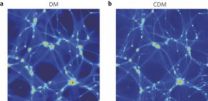Fine-scale climate model projections predict malaria at local levels
2014-07-02
(Press-News.org) Fine-scale climate model projections suggest the possibility that population centers in cool, highland regions of East Africa could be more vulnerable to malaria than previously thought, while population centers in hot, lowland areas could be less vulnerable, according to a team of researchers. The team applied a statistical technique to conventional, coarse-scale climate models to better predict malaria dynamics at local levels.
"People might have an interest in predictions for global malaria trends and even more so for regional patterns, but they probably care most about what's going to happen in their own town or village," said Matthew Thomas, professor and Huck Scholar in Ecological Entomology, Penn State. "We found that malaria predictions using global climate model simulation results don't necessarily tell you what's going to happen at a specific location. What is likely to happen in one location can be very different from another location just 50 miles down the road. To really understand the impact of climate change on malaria dynamics we need to adopt a higher-resolution approach."
According to Krijn Paaijmans, assistant research professor, Barcelona Centre for International Health Research, the ability of mosquitoes to transmit malaria is strongly influenced by environmental temperature.
"Malaria mosquitoes are ectothermic organisms, which means that their body temperature matches the temperature of their direct surroundings," Paaijmans said.
The scientists examined how changes in temperature due to future climate warming might impact the potential for mosquitoes to transmit malaria. The researchers compared malaria transmission at four sites in Kenya that differed in their baseline environmental characteristics -- two sites were cool upland locations, a third site was a warm lower-altitude site and a fourth site was a hot savannah-like environment.
The team used a statistical technique to "downscale" projections from conventional global climate models -- specifically, projections from atmosphere-ocean global climate models (AOGCMs), which evaluate temperature on coarse spatial and temporal scales -- to generate high-resolution, daily temperature data.
"Statistical downscaling takes historically observed relationships between the large-scale atmospheric state and a local climate response, and applies them to global climate model projections," said Robert Crane, professor of geography, Penn State. "We applied the downscaling methodology to the climate model projections."
The team's goal was to predict malaria transmission potential within the four locations. They used a simple mathematical model that describes the influence of temperature on the ability of adult mosquitoes to transmit malaria parasites to compare the predictions they obtained in the four locations with the predictions from the coarse-scale model simulations.
"Fine-scale predictions of malaria risk will be better tailored to the needs of local communities and can improve local adaptation and mitigation strategies," Paaijmans said.
The results appear in the June 19 issue of Climatic Change.
The team found that the conventional approach of using coarse-scale climate models yielded different predictions for future changes in malaria transmission potential in the four locations than when they applied the downscaling methodology.
"Using the raw coarse-scale model simulation results sometimes overestimated and sometimes underestimated the effects of climate change for particular locations compared with our downscaled model results," Thomas said.
Specifically, the team's downscaled model results predicted large increases in future malaria transmission potential in the cool upland sites, but reduced transmission in the hot savannah-like site. The results also predicted an increase in transmission potential in the warm lower-altitude site, but the increase was less pronounced when using the downscaling methodology than when using the conventional models. According to the researchers, the warm lower-altitude site is characterized by relatively consistent, year-round transmission, so even modest increases in transmission potential may translate into measurable changes in disease risk.
"This is one of the first studies to attempt to explore how climate change might impact conditions at the local level," said Michael Mann, Distinguished Professor of Meteorology, Penn State. "The results suggest the possibility that population centers in cool highland regions could be more vulnerable than previously thought, while other equally large lowland areas might be less vulnerable. But this would have to be confirmed with more detailed modeling assessments that take into account the full suite of environmental and socio-economic factors that ultimately determine risk of malaria."
INFORMATION:
Other authors on the paper include Justine Blanford, research associate in geography, Penn State; Liang Ning, postdoctoral fellow, University of Massachusetts - Amherst; and Kathleen Schreiber, professor of geography, Millersville University of Pennsylvania.
This research was supported by the U.S. National Science Foundation.
ELSE PRESS RELEASES FROM THIS DATE:
Food allergies: A new, simple method to track down allergens
2014-07-02
Although food allergies are common, sufferers often don't know exactly what in foods cause their allergic reactions. This knowledge could help develop customized therapies, like training the body's immune system to respond to certain proteins found in foods. However, determining which protein in a food causes an allergic response to a patient requires time-consuming tests that often ignore rare or unexpected allergens. Publishing in Analytical Chemistry, EPFL scientists have developed a highly-sensitive method that can quickly and accurately identify the culprit proteins ...
Socioeconomic status associated with peripheral artery disease risk
2014-07-02
Previous research has established a link between lower socioeconomic status and an increased risk of cardiovascular disease. In a new study led by Brigham and Women's Hospital (BWH), researchers have found that there are also higher rates of peripheral artery disease (PAD) in individuals with low income and lower attained education levels in the United States.
These findings are published online ahead of print in Circulation: Cardiovascular Quality and Outcomes.
"Our finding highlights the need to focus on education and advocacy efforts for these at-risk populations," ...
Reinterpreting dark matter
2014-07-02
This news release is available in Spanish.
In cosmology, cold dark matter is a form of matter the particles of which move slowly in comparison with light, and interact weakly with electromagnetic radiation. It is estimated that only a minute fraction of the matter in the Universe is baryonic matter, which forms stars, planets and living organisms. The rest, comprising over 80%, is dark matter and energy.
The theory of cold dark matter helps to explain how the universe evolved from its initial state to the current distribution of galaxies and clusters, the structure ...
Weekend emergency surgeries deadlier for children
2014-07-02
Children who undergo simple emergency surgeries, such as hernia repairs or appendix removals, on weekends are more likely to suffer complications and even die than children getting the same kind of treatment during the week, according to results of a Johns Hopkins Children's Center study.
The Johns Hopkins team says that although the number of deaths was small, the marked difference in death and risk of other complications points to a worrisome "weekend effect" observed across hospitals nationwide that calls for an in-depth examination of possible after-hours safety lapses ...
One in six adolescents in the ER has experienced dating violence
2014-07-02
WASHINGTON — Of adolescents visiting the emergency department for any reason, one in five girls and one in eight boys reported dating violence in the past year. According to a study published online Monday in Annals of Emergency Medicine, dating violence among adolescents was also strongly associated with alcohol, illicit drug use and depression ("Dating Violence Among Male and Female Youth Seeking Emergency Department Care") http://tinyurl.com/oakk4aq.
"An enormous number of youth and adolescents have already experienced violence in their dating lives," said lead ...
A stellar womb shaped and destroyed by its ungrateful offspring
2014-07-02
This image was taken as part of the ESO Cosmic Gems programme [1] using the Wide Field Imager on the MPG/ESO 2.2-metre telescope at the La Silla Observatory in Chile. It shows Gum 15, located in the constellation of Vela (The Sails), some 3000 light-years from Earth [2]. This glowing cloud is a striking example of an HII region [3]. Such clouds form some of the most spectacular astronomical objects we can see; for example the Eagle Nebula (which includes the feature nicknamed "The Pillars of Creation"), the great Orion Nebula , and this less famous example, Gum 15.
Hydrogen ...
'Deep learning' makes search for exotic particles easier
2014-07-02
Irvine, Calif. — Fully automated "deep learning" by computers greatly improves the odds of discovering particles such as the Higgs boson, beating even veteran physicists' abilities, according to findings by UC Irvine researchers published today in the journal Nature Communications.
"We are thrilled with the publication of our work," said co-author Pierre Baldi, Chancellor's Professor of computer science, "and even more so with the hope that deep learning may help solve fundamental open questions about the nature of matter, gravity and the origin of the universe."
Baldi, ...
Superconducting-silicon qubits
2014-07-02
Theorists propose a way to make superconducting quantum devices such as Josephson junctions and qubits, atom-by-atom, inside a silicon crystal. Such systems could combine the most promising aspects of silicon spin qubits with the flexibility of superconducting circuits. The researcher's results have now been published in Nature Communications (1).
High quality silicon is one of the historical foundations of modern computing. But it is also promising for quantum information technology. In particular, electron and nuclear spins in pure silicon crystals have been measured ...
From despair to repair: Dramatic decline of Caribbean corals can be reversed
2014-07-02
Gland, Switzerland – With only about one-sixth of the original coral cover left, most Caribbean coral reefs may disappear in the next 20 years, primarily due to the loss of grazers in the region, according to the latest report by the Global Coral Reef Monitoring Network (GCRMN), the International Union for Conservation of Nature (IUCN) and the United Nations Environment Programme (UNEP).
The report, Status and Trends of Caribbean Coral Reefs: 1970-2012, is the most detailed and comprehensive study of its kind published to date – the result of the work of 90 experts over ...
License plate readers are important police tool, but hurdles remain, study finds
2014-07-02
Systems that automatically read automobile license plates have the potential to save police investigative time and increase safety, but law enforcement officials must address issues related to staffing, compatibility and privacy before the technology can reach its full potential, according to a new RAND Corporation report.
As part of efforts to promote innovation in law enforcement, many of the first generation license plate reader systems were purchased with federal and state grants. As these funding streams can be inconsistent, law enforcement agencies are – or will ...



